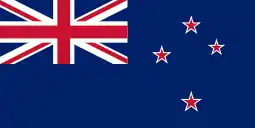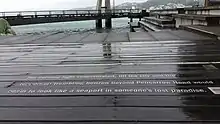New Zealand literature
New Zealand literature is literature written in or by the people of New Zealand. It may deal with New Zealand themes or places, but some literature written by New Zealanders focusses on non-parochial themes and places. The concept of a "New Zealand literature" originated primarily in the 20th-century, inspired particularly by essays such as Bill Pearson's Fretful Sleepers — A Sketch of New Zealand Behaviour and its Implications for the Artist (1974).[1] New Zealand literature is produced predominantly in the English language, and as such forms a sub-type of English literature.
| Part of a series on the |
| Culture of New Zealand |
|---|
 |
|
| History of literature by region or country | |||||
|---|---|---|---|---|---|
| General topics | |||||
|
|||||
| Middle Eastern | |||||
| European | |||||
|
|||||
| North and South American | |||||
|
|||||
| Australasian | |||||
| Asian | |||||
|
|||||
| African | |||||
|
|||||
| Related topics | |||||
|
| |||||
Early New Zealand literature
The first printing press arrived in New Zealand in 1834. The first book published was a Māori language version of the Bible Ko te katikihama III in 1830.[2] Early New Zealand books include from the early 1870s, A History of the Birds of New Zealand by ornithologist Walter Buller and plates by the artist JG Keulemans. Only 500 copies were ever printed and is a collectors item and known colloquially as “Buller’s birds”. And earlier natural history artist George French Angas from 1847 The New Zealanders Illustrated. It is a very rare book.[3]
The Māori did not have a written form of language until contact with Europeans in the early 19th century. Oratory and recitation of whakapapa has a special place in Māori culture; notions of 'literature' may fail to describe the Māori cultural forms of the oral tradition.
In the early nineteenth century Christian missionaries developed written forms of Polynesian languages including Māori language in New Zealand. The oral tradition of story telling and folklore has survived and the early missionaries collected folk tales.
Poetry

Poetry has been part of New Zealand culture since before European settlement in the form of Māori sung poems and waiata. Early colonial poetry, written by immigrants from the United Kingdom, was also predominantly sung poetry, and was primarily concerned with traditional British themes. New Zealand poetry developed a strong local character from the 1950s, and has now become a "polyphony" of traditionally marginalised voices.[4] Notable New Zealand poets include Janet Frame, R. A. K. Mason, C. K. Stead, James K. Baxter, Hone Tuwhare, Sam Hunt, Vincent O'Sullivan and Bill Manhire. The National Library of New Zealand appoints a New Zealand Poet Laureate biennially.
Writers
Novelists Janet Frame, Patricia Grace, Albert Wendt, Maurice Gee and children's author Margaret Mahy, are prominent in New Zealand.[5] However, there is also a strong current of work written independently with little concern for international markets and having only a small readership, such as Ian Wedde's early novel Dick Seddon's Great Dive (1976). Novelists such as Kirsty Gunn [6] exemplify the shift to less parochial concerns.
Keri Hulme gained prominence when her novel, The Bone People, won the Booker Prize in 1985. Likewise Canadian-born, New Zealand raised Eleanor Catton with her Booker Prize of 2013 for her novel The Luminaries. Witi Ihimaera wrote the novel that became the critically acclaimed movie Whale Rider, directed by Niki Caro. His works deal with Māori life in the modern world, often incorporating fantastic elements.
Writers popularly and intellectually claimed by New Zealand as its own include immigrants, such as Eleanor Catton and South African-born Robin Hyde, and emigrants who went into exile but wrote about New Zealand, like Dan Davin and Katherine Mansfield. Erewhon, although a novel set in New Zealand and written by Samuel Butler as a result of a 5-year stay in New Zealand, arguably belongs primarily to English literature. Likewise the New Zealand work of Karl Wolfskehl, resulting from his 10-year sojourn in Auckland (where he died), is seen at present as belonging rather to the story of German literature.
This contemporary recognition or non-recognition of a writer as a New Zealand writer is part of the ongoing popular and intellectual debate about New Zealand identity. Consequently, such attitudes should not at all be regarded as fixed.
Playwrights
New Zealand has a lively community of playwrights in theatre. Significant playwrights include Roger Hall, Hone Kouka, Briar Grace-Smith and Renée. Support for playwrights and plays in New Zealand is provided by Playmarket, a national organisation which also publishes and sells plays and scripts.[7]
New Zealand also has a tradition of independent theatre which does not subscribe to commercial theatrical norms. One might cite Red Mole theatre group (1970s-2002), some work by Mervyn Thompson, the early work of Paul Maunder, in Christchurch Pacific Underground and the Free Theatre (1984–present), and in Wellington Barbarian Productions led by Jo Randerson. These groups have arguably nourished the intellectual sub-stratum of New Zealand theatre. Foreskin's Lament is a notable New Zealand play about rugby culture - by South Islander Greg McGee - famous for its closing speech by the titular character.
See also
References
- Bill Pearson, Fretful Sleepers (1974), http://nzetc.victoria.ac.nz/tm/scholarly/tei-PeaFret.html
- Binney, Judith (1990). "Yate, William". Te Ara - the Encyclopedia of New Zealand. New Zealand Ministry for Culture and Heritage Te Manatu Taonga. Retrieved 2021-01-16.
- "A Search for the Holy Grail of Rare Books". Newsroom. 2020-07-08. Retrieved 2021-01-16.
- Green, P., & Ricketts, H. (2010). 99 Ways into New Zealand Poetry. Auckland: Random House.
- Swarbrick, Nancy (13 January 2009). "Creative life". Te Ara - the Encyclopedia of New Zealand. Retrieved 2009-04-26.
- Kirsty Gunn, http://www.bookcouncil.org.nz/writers/gunnkirsty.html
- "Playmarket". Playmarket. Retrieved 2021-01-16.
Further reading
- Stafford, Jane; Williams, Mark, eds. (2012). Anthology of New Zealand literature. Auckland, N.Z.: Auckland University Press. ISBN 9781869405892.
External links
- Braunias, Steve (March 20, 2004). "The 50 best New Zealand books". New Zealand Listener (3332). Retrieved 3 June 2012.
- New Zealand Electronic Text Centre
- New Zealand Electronic Poetry Centre
- New Zealand Book Council
- Dunedin City of Literature